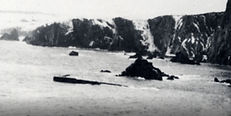
TRUXTUN & POLLUX
From The Treasury of Newfoundland Stories published, by Maple Leaf Mills Limited, in 1961
Little did the people of St. Lawrence dream upon retiring Tuesday night, Feb. 17, 1942 that on awakening one of the worst sea disasters in United States naval history would have happened right on their doorstep. The disaster occurred when the 1,200-ton destroyer Truxtun crashed ashore at Chamber Cove on the outer side of St. Lawrence and almost simultaneously, the 6,085-ton supply ship Pollux ran aground at Lawn Point a mile and a half westward.
The disaster occurred at 4.30 in the morning in the height of a blinding snow storm. Far was it from the thoughts of those men working at Iron Springs Co., that death and distress was lurking in the angry sea less than a mile away. One can visualize their surprise and dismay when a water-soaked oil-covered U.S. sailor from the Truxtun approached them, bringing news of the tragedy. He with three other crew members had succeeded in reaching land and, after scaling the icy cliffs they were making a desperate attempt to find assistance for their crew mates still aboard the doomed ship.
Immediately all mining operations were suspended and the miners, with all the necessary equipment, rushed to the scene. As the news spread through the town, residents hastened to join in the rescue.
From the vantage point of the almost unscalable cliffs, nearly 200 feet high at Chamber Cove, the indescribable scene was presented. Heavy seas crashed over the remains of the doomed vessel, and men clung desperately to the wreckage while waves were dashing them back in the angry waters.
The storm and the mountainous seas made the task of rescue most hazardous. Men were lowered down by ropes over the precipitous cliffs, time and time again, ricking their lives as in many cases they plunged into seas to secure a victim from the hungry waves or from rocks on which a precarious foothold had been obtained. The indomitable courage typical of the true Newfoundlander was displayed, and little thought was given to the risk as long as a life could be saved.
Rescuers attempted getting a rope across the cove to make connections with the wreck, but strength of wind defeated them. In hopes of saving three men clinging to the wreckage, two men volunteered to be lowered down over the cliffs in a dory. They reached the wreck, saved two men, were swamped coming back, and one local man was washed overboard. As he was seized in the nick of time by his companions and hauled to safety. And so the hazardous task of rescue continued all through the day, till the last living men had been landed.
Many and sad were the scenes that presented themselves. While this rescue was proceeding news came that a second ship, the Pollux, was ashore at Lawn Park. And so, as many men as could be spared proceeded there to join others from the nearby town of Lawn. A boat from the Pollux was successful in getting a line ashore. By this means and other contrivances the rescues were effected. When taken from the water the survivors for the most were in a bad way - covered in crude oil, frostbitten, damaged by their buffeting, exhausted by their ordeal.
They were carried as quickly as possible to Iron Springs, where emergency First Aid stations had been prepared. By this time salvage ships had arrived from Argentia bringing medical aid. These professionals, along with men and women of the town, worked incessantly and untiringly to restore life and ease to the suffering.
They were then moved to St. Lawrence where the people opened their homes to them, provided them with food and clothing, and in every way possible administered to their ease and comfort. After two days of recuperation in these hospitable homes, they were removed by salvage ships to the hospital at Argentia.
Quoting A.L. Bristol Rear Admiral U.S. Navy at that time in his letter of gratitude to the people of St. Lawrence, "Memories of such acts can never die, and the total of almost two hundred men and officers saved on this occasion will stand as a monument to the people of St,. Lawrence and all Newfoundland, in the hearts and minds of all who know the story."
In generous recognition of the services rendered, the United States Government has erected at St. Lawrence a modern, three story hospital. the all-concrete structure, completed in 1954, is known as the United States Memorial Hospital. This hospital has been taking care of the medical needs of St. Lawrence, Lawn and nearby towns most adequately. Many the time this quotation has been made by a grateful townsfolk - "THEY DID NOT DIE IN VAIN".
Survivors 186.
Victims approximately 200.


Echoes of Valour
Dedicated to the victims of the mining industry in St. Lawrence, to the sailors who tragically died in the U.S.S. Truxtun & U.S.S. Pollux disaster on February 18, 1942 at Chambers Cove and Lawn Point, and to the remembrance of the valiant men who fought and died for
our freedom during World Wars.
August 2, 1992





